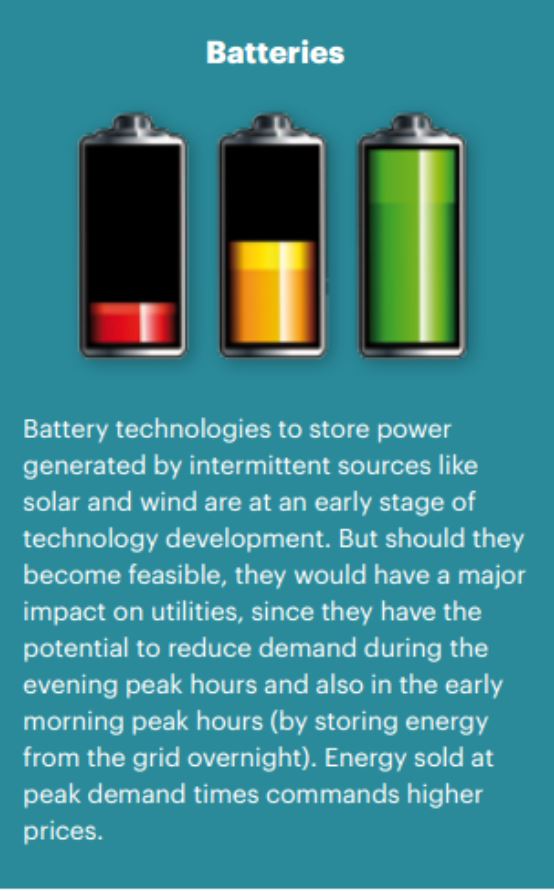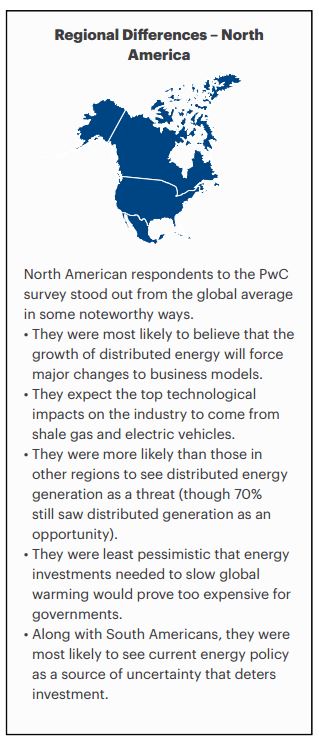by | Rushdi Abdul Rahim
Driving Forces Creating New Model
The longstanding, overarching business model in the electric power industry involves a combination of power generation, power distribution, and retail sales over a common electric grid. Rising demand for power and high credit ratings have enabled capital investments in new capacity with reliable long-range payback through a combination of regulated and unregulated income.
Now, despite the fact that global demand will continue to grow, a variety of technical and societal drivers are poised to create major disruption of this business model. In 2013, PwC conducted its 13th Annual Global Power & Utilities Survey with senior leaders from 53 power and utilities companies in 35 nations of Europe (including Russia), the Americas, Africa and the Middle East, and the Asia Pacific region.
Based on the results of this survey and other sources, this brief examines the forces driving change in the global power industry, potential outcomes, and implications for governments and the greater business community.
DRIVING FORCES
Although they serve a well-established global market experiencing increasing demand, an overwhelming 94% of power and utilities executives surveyed by PwC expect “complete transformation or important changes to the power utility business model.” Transformational change is most widely expected in Asia, followed by Europe, and least expected in the Middle East and Africa. A variety of driving forces are poised to disrupt the status quo.
Rise of renewable energy sources. Lower prices for solar panels and higher prices for electricity mean that solar power generation will become economically viable without subsidies. According to UBS Investment research, up to 18% of electricity demand in Germany, Italy, and (with a time delay) Spain could be met by unsubsidized solar. “On our estimates for 2020, electricity bills could be reduced by 20– 30%, and the payback time would be 5–6 years for commercial solar systems and 10–11 years for residential systems.”According to a September 2012 report from Citi Research, “Solar is already competitive versus domestic electricity prices for many countries, with many more to follow soon.” In Europe, demand for conventionally generated electricity from the grid is also being reduced by subsidized renewable electricity generation (wind and biomass) and by energy efficiency programs.
Rise of distributed energy generation. While growth of distributed energy generation in Europe has been supported by subsidies, improving economics mean “we are likely to move into a phase where take-up is commercially and market-led.”According to the Edison Electric Institute, emerging technologies that could compete with utility-supplied power include solar photovoltaics, fuel cells, geothermal energy, wind, microturbines, battery storage, and electric vehicle enhanced storage. “As the cost curve for these technologies improves, they could directly threaten the centralized utility model.” (In the US currently less than 1% of total electrical load has been lost to distributed energy generation.) Two-thirds of PwC survey participants (including 82% of those in North America and 77% of those in Asia) expect that future energy demand will be met by a mixture of centralized and distributed generation.
Distributed energy generation creates price pressure. One of the key technical challenges facing distributed generation is the need to provide steady power even though most distributed sources operate intermittently. Meeting this challenge adds costs, creating a business challenge: prices rise for consumers who continue to use central electricity sources. (Often, under current regulatory schemes, distributed-energy customers are effectively subsidized by other customers.) There is the danger of a vicious cycle, as rising prices drive more consumers to distributed power solutions, making the grid more complex and further raising costs and prices.

Energy efficiency, demand-side management, and smart grids, along with falling prices for solar panels, are among the technologies survey respondents rate as having the greatest impact on their market. The Edison Electric Institute notes increasing interest in demand-side management on the part of customers, regulators, and political bodies in the US. A 2012 report from GTM Research argues that the addition of big data and analytics technologies gives smart grid technology the potential to completely reinvent the utility industry.
Changes to conventional power generation. When decentralized energy generation reduces peak demand, conventional energy generation can become unprofitable; this is already an issue in Germany. UBS forecasts that the increase in installed solar capacity in Europe will reduce the load factor on lignite coal plants from 72% to 59% by 2020, on hard coal plants from 47% to 31%, and on gas plants from more than 40% to less than 20%.
Shale gas and tight oil. The growth of the shale gas supply in North America is forcing revision of peak oil forecasts, allowing increased US coal exports, and putting North American energy independence within reach. One consequence has been lower European coal prices, making operating margins for coal plants in Europe higher than margins for gas- fired plants, and exacerbating forces leading to the closing of gas-fired power plants in Europe. Many other countries have shale gas resources, but the rate at which they are exploited will depend on local energy policies, economics, and politics.
Regulations. Globally, 68% of participants say that regulated energy tariffs are too low to cover the cost of new generation capacity, while 62% say that political and regulatory uncertainty are deterrents to developing large-scale new capacity. According to survey respondents, the most important policy approaches to ensuring that demand is met in future decades are “a regulatory environment that encourages network investment,” “increased interconnection,” and “fast-track planning and permitting for strategic infrastructure.”
Energy-saving, energy-generating consumers. Only 9% of respondents currently see customers actively engaged in energy saving and/ or energy generating, yet 41% believe their customers will be engaged in these activities 10 years from now.
POWER INDUSTRY IMPACT
These forces are poised to drive substantial change in the electric power industry. The good news is that fully 82% of PwC survey respondents regard distributed power generation as an opportunity; only 18% see it as a threat.
 Business challenges
Business challenges
These driving forces are creating substantial business challenges; three challenges will have the most significant impact.
- Balancing cost, security, and the environment. As PwC points out, these three considerations are simultaneously growing in importance and are often in conflict. In particular, complex grids balancing distributed, intermittent power with central power sources may be more prone to blackouts, and shale gas production raises fresh environmental concerns.
- Regulatory and other uncertainty. Some 55% of PwC survey respondents (and 67% in North America) agree that energy policymakers “have produced a significant amount of policy uncertainty that is undermining investment.”
- Business model disruption. Technology, regulatory, and consumer forces will require electric power companies to adopt new business models in order to remain relevant and competitive.
Possible outcomes
Major changes are anticipated for an industry that once was stable and changed slowly.
- Changing sources of power. PwC notes that falling prices for distributed power generation and increasing supplies of shale gas could work in synergy, with on-demand gas-fired power production used to complement intermittent distributed sources. According to Citi Research, “shale and renewables could be the making of each other” and “gas is a transition fuel to a lower- carbon world,” because renewable energy—particularly solar and wind energy—is rapidly becoming cost competitive in many parts of the world. (PwC notes that coal could serve a similar role where regulations permit.) According to the US Energy Information Administration’s 2013 Annual Energy Outlook, new capacity added in the US through 2040 will be primarily natural gas power and renewables (predominantly wind and solar).
- Revenue pressure. For the US, the Edison Electric Institute notes that current forces will tend to reduce revenue and shareholder return; this will in turn reduce creditworthiness, making capital for system improvements and expansion more difficult to obtain. More frequent blackouts. As already noted, failing to meet the challenge of providing steady power availability—as an increasing percentage of power generation shifts to distributed, intermittent sources—raises the likelihood of power blackouts. When asked how current trends in their own power market are impacting the likelihood of power outages, 37% of respondents are neutral, 37% believe risk is increasing, and 26% believe risk is decreasing.
- Efficiency improvements. Some 65% of survey participants believe that there is opportunity for power companies to achieve cost reductions and efficiency improvements of more than 10%; 31% of respondents think improvements of more than 20% are feasible. In the view of PwC, the role of efficiency improvements is to create “strategic headroom,” giving power companies time and resources to adjust to long-term shifts in business models.
- Regulatory changes. Responding to the survey results, PwC notes, “There is a feeling that regulation is at a crossroads” and that, going forward, regulatory certainty will be valued more highly than liberalization of regulations, as major capital investments will be needed to accommodate an era of distributed generation and renewable energy.
- Business model transformation. While it’s not possible to specify future business models, key strategic questions include:
- Where are the most attractive revenue opportunities?
- How far and how fast will distributed power generation grow?
- What will be the role of natural gas in the shale gas era?
- What roles will transmission-system and distribution- system operators adopt in response to smart energy grids, demand-side management, and distributed generation?
- How can energy companies improve operational efficiency to free up resources and buy time to respond to change?
- How can power companies best partner with energy- conserving and energy-generating customers?
- Decline into irrelevance? The PwC report is clear that the very survival of power industry companies depends on their ability to adapt to forces of change. “How companies respond to these changes will determine whether they will be part of the future or join the ranks of companies from other industries whose business models have been eclipsed by technological and market change.” The rise of distributed energy generation “could shrink the role of unwary power utility companies to operators of back-up infrastructure.”
Future Scenarios
Participants in the PwC survey were presented with five scenarios about the future of the power industry and asked to evaluate their probability.
|
Scenarios |
Low Probability |
Medium to High Probability |
|
1. Technological advances and new sources such as shale gas will dramatically reduce dependence on oil- and gas-rich countries, and change the power balance between buyers and sellers. |
33% |
67% |
|
2. Power utility companies need to become much more tariffclever, perhaps learning some bundling and ‘free allowance’ tricks from mobile telephony. |
36% |
64% |
|
3. In the coming decades, we could see the death of the current energy retailing business model in some major world markets because of the rise of distributed generation. |
52% |
48% |
|
4. In the future, concerns about energy security will become a thing of the past due to technological changes and new sources of energy. |
45% |
54% |
|
5. The nuclear/ renewable investments needed to avoid significant global warming (two degrees or less) will prove too costly for governments to support. |
32% |
68% |
Particularly noteworthy are the relatively high probabilities assigned to scenario 3, the death of current business models in some markets; scenario 4, forecasting a new era of energy abundance; and scenario 5, suggesting that economic issues will prevent governments from successfully limiting global warming.
BUSINESS IMPLICATIONS
The changes coming to electric utilities will have implications for a wide variety of businesses and organizations.
- As renewable energy, especially solar, becomes cost competitive with grid-supplied electricity, organizations of all kinds should consider supplying some of their power needs on-premises. Global organizations should anticipate the crossover points at which self-generation becomes economically viable in each of the countries in which they operate.
- In the shorter term, organizations should anticipate that the advent of distributed generation could put upward pressure on conventional energy prices. Within this context, organizations that fail to adopt distributed generation or move to it late could suffer higher than necessary energy costs.
- With the growth of distributed generation widely anticipated in many markets, companies that can develop and supply infrastructure and information technology to enable distributed generation should find growing markets.
- Demand-side management strategies are also expected to grow in importance. Businesses will find that there are real incentives to optimize their energy demand across various times of the day and days of the week. Big data analytics may help larger organizations optimize their energy usage and costs. There will also be opportunities to provide businesses and consumers with tools, software, services, etc. for demand-side energy management. One important question for energy and related firms is whether they will be the ones to innovate in this space—or if startups (e.g., Nest Labs) and infotech firms (e.g., Google) will identify and capitalize on these emerging opportunities first.
- The continued availability of shale gas is assumed in the PwC survey and analysis. An environmental disaster or other unexpected event that interrupts the growth of shale gas could change some of the possible futures described here. Organizations should consider what such a wildcard would do to their energy costs and availability.
- A significant minority of survey respondents believes that current developments in the electric power industry are increasing the risk of blackouts. Organizations may wish to update their contingency plans for power outages at key facilities.
- As distributed generation grows, power providers will be looking for ways to partner with customers on energy strategies. Organizations should remain open to partnerships with utilities to optimize their energy usage. Organizations should also anticipate a wider variety of usage plans and payment options from “tariff-clever” utilities










